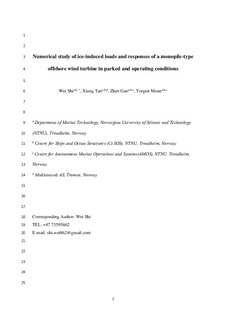| dc.contributor.author | Shi, Wei | |
| dc.contributor.author | Tan, Xiang | |
| dc.contributor.author | Gao, Zhen | |
| dc.contributor.author | Moan, Torgeir | |
| dc.date.accessioned | 2017-10-30T09:37:01Z | |
| dc.date.available | 2017-10-30T09:37:01Z | |
| dc.date.created | 2016-01-11T09:38:46Z | |
| dc.date.issued | 2016 | |
| dc.identifier.citation | Cold Regions Science and Technology. 2016, 123 121-139. | nb_NO |
| dc.identifier.issn | 0165-232X | |
| dc.identifier.uri | http://hdl.handle.net/11250/2462775 | |
| dc.description.abstract | Offshore wind is an attractive source of renewable energy. In regions with cold climates, such as Canada, the Baltic Sea, and Bohai Bay, a good understanding of ice loads is essential to design a reliable and cost effective support structure for an offshore wind turbine. This paper presents a study of the dynamic ice–structure interaction of a commonly used monopile-type offshore wind turbine in drifting level ice in both parked and operating conditions. A semi-empirical numerical model for ice–structure interaction was coupled to the aero-hydro-servo-elastic simulation tool HAWC2. A convergence study was performed to determine the proper time step and simulation length to obtain reliable response prediction. The simulated ice load was compared with the formulations in international standards. The coupling between the ice loads and the structural response of the monopile-type wind turbine was investigated and found to be important. The effects of the ice characteristics (e.g., ice thickness and drifting speed) were examined with the turbine being in parked and operating conditions. Compared with current numerical model, standards from International Electrotechnical Commission (IEC) and International Organization for Standardization (ISO) predict lower ice loads. 3-D effect of ice–monopile interaction and failure of local ice sheet are considered. More stochastic dynamic phenomena are captured for ice–structure interaction in our numerical model. The effect of the ice thickness on the response was found to be significant. A negligible drifting speed effect is found on the bending moment response in the fore-aft direction. There is a large increase in the fore-aft response as the inclination angle of the cone increases. Further sensitivity studies and validation against model tests will be performed for the conical waterline of the wind turbine. | nb_NO |
| dc.language.iso | eng | nb_NO |
| dc.publisher | Elsevier | nb_NO |
| dc.rights | Attribution-NonCommercial-NoDerivatives 4.0 Internasjonal | * |
| dc.rights.uri | http://creativecommons.org/licenses/by-nc-nd/4.0/deed.no | * |
| dc.title | Numerical study of ice-induced loads and responses of a monopile-type offshore wind turbine in parked and operating conditions | nb_NO |
| dc.type | Journal article | nb_NO |
| dc.type | Peer reviewed | nb_NO |
| dc.description.version | acceptedVersion | nb_NO |
| dc.source.pagenumber | 121-139 | nb_NO |
| dc.source.volume | 123 | nb_NO |
| dc.source.journal | Cold Regions Science and Technology | nb_NO |
| dc.identifier.doi | 10.1016/j.coldregions.2015.12.007 | |
| dc.identifier.cristin | 1309534 | |
| dc.relation.project | Norges forskningsråd: 223254 | nb_NO |
| dc.description.localcode | © 2015. This is the authors’ accepted and refereed manuscript to the article. LOCKED until 22.12.2017 due to copyright restrictions. This manuscript version is made available under the CC-BY-NC-ND 4.0 license http://creativecommons.org/licenses/by-nc-nd/4.0/ | nb_NO |
| cristin.unitcode | 194,64,20,0 | |
| cristin.unitname | Institutt for marin teknikk | |
| cristin.ispublished | true | |
| cristin.fulltext | postprint | |
| cristin.qualitycode | 2 | |

